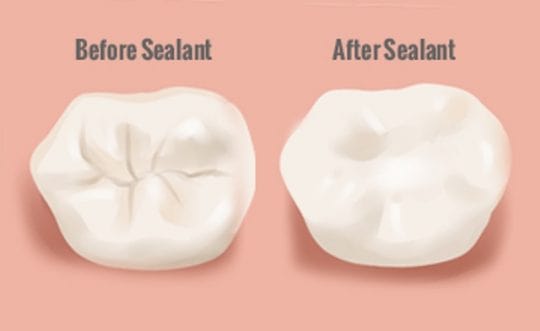The health of the average American is in a state of decline and decreasing dental health is also part of trend. The Centers for Disease Control and Prevention has noted that untreated tooth decay is the norm for approximately one-third of all adults and that the condition affects more than one-fourth of U.S. children aged 2–5 years. Dental sealants have long been touted as a type of preventative dentistry for the latter, however the dental treatment is shrouded in controversy.
In children, tooth decay most commonly starts in the back of the mouth and factors such as poor oral hygiene and poor nutrition are the biggest contributor to the dental problem. Combined those behaviors can cause levels of dental plaque (and subsequently tooth decay) to rise. For decades dental sealants have been applied to prevent cavities in children and while the plastic coatings may indeed reduce dental problems from developing, there are other risks that have caused dental sealants to be shrouded in controversy.The Good
Dentistry.com notes that dental sealants are “Made of plastic resin, these tooth sealants are applied to the grooves of premolars and molars to seal-out cavity-causing bacteria and food.” Since tooth decay starts at an early age the devices have long been utilized as a type of preventative dentistry for children.
The first incarnation of the dental treatments launched in the mid-1950s and at that time it was called enamel bonding. As science evolved so did this type of dental treatment and by the late 1960s dental sealants we formally introduced and by the early 1970s the devices were acknowledged as being by the American Dental Association.
The practice of applying dental sealants got a major boost in the 1990s. At that time, the United States Public Health Service recommended that by the year 2000, 50 percent of children should have at least one sealant.
Presently the dental treatment is thought to be an essential way to help control the nation’s tooth decay epidemic by the Pew Center on the States. The Pew Center is an independent think tank dedicated to analyzing issues that will impact the future of the country. The dental health of children is one such hot topic and the organization has taken to releasing report cards regarding how well each state handles the task and not having a state supported dental sealant program is considered to be a major negative on the organization’s rating system.The Bad
Despite various agency encouraging the coating of baby teeth (specifically molars) in children, less than 40 percent of dentists follow the practice (http://www.ncbi.nlm.nih.gov/pubmed/21881070). This move is in direct contradiction to the 2010 American Dental Association official recommendation of the practice.
The fact was unearthed courtesy of a study conducted in September of 2011. At that time study authors dispersed a questionnaire to a random group of 2,400 general dentists (GDs) and pediatric dentists (PDs) in America. The survey asked the group participants to look at “two photographs of NCCLs (permanent first molar and premolar) in a 12-year-old child. Respondents were provided with radiographic findings and asked to choose from several management options,” (http://www.ncbi.nlm.nih.gov/pubmed/21881070).
The results showed that many dentists opted not to apply the coating and instead choose other options such as tooth extractions to deal with the dental problem. This is alarming as dentists across the nation have reported an increase of preschoolers of all income levels sporting multiple cavities and tooth decay on baby teeth and have been relying on the powers of general anesthesia to help deliver the essential dental treatments to improve the conditions.The Ugly
That research has indicated that in order to get more dentists into the dental sealant groove “New educational and dissemination programs should be developed regarding these evidence-based caries management approaches.” Even with that change, some dentists may choose to skip dental sealants for another reason altogether.
Over the past few years research has found that Bisphenol A (BPA) an organic compound present in dental sealants may seep over time and potentially put children’s oral health and wellness in jeopardy. The news came to light circa 2009 when American health agencies started to release documentation regarding the level of BPA in consumer products. In response to the concerns, the government authorized millions of dollars in grant money to research the issue. The U.S. Food and Drug Administration (FDA) National Center for Toxicological Research has been conducting research on the effects of the additive as well as implementing a multitude of steps to limit the exposure to humans via food containers, baby bottles and infant feeding cups via the manufacturing process.
Dental sealants are made of plastic polymers, BPA and all. As the plastic is continually exposed to moisture (courtesy of saliva, water and foods consumed) it can slightly weaken the structure of dental sealants. Over time BPA may leach and expose children to the risks associated with the chemical.
Although the risks of BPA are real, the ADA says the benefits of dental sealants far outweigh the risks. Only a parent can truly decide and determine what is best for their child and the advice from a professional dental care expert will provide invaluable insight to those in need.

